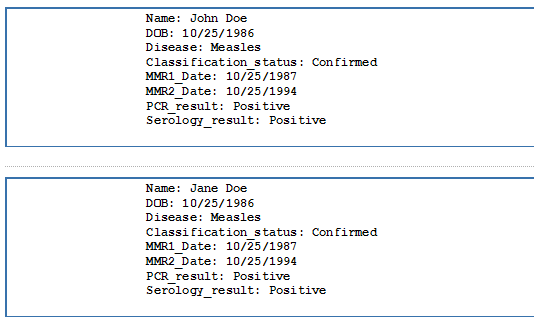- Home
- /
- Programming
- /
- Programming
- /
- How do I transform my data from table form to paragraph form?
- RSS Feed
- Mark Topic as New
- Mark Topic as Read
- Float this Topic for Current User
- Bookmark
- Subscribe
- Mute
- Printer Friendly Page
- Mark as New
- Bookmark
- Subscribe
- Mute
- RSS Feed
- Permalink
- Report Inappropriate Content
I have a line list of cases that includes information like name, DOB, date of symptom onset, vaccination status, classification status, lab results, etc. I wan to take this information and get a print out of each of these fields per person with one person on each page. For example:
This
| Name | DOB | Disease | Classification status | MMR1 Date | MMR2 Date | PCR result | Serology result |
|---|---|---|---|---|---|---|---|
| John Doe | 10/25/1986 | Measles | Confirmed | 10/25/1987 | 10/25/1994 | Positive | Positive |
Becomes this
Name: John Doe
DOB: 10/25/1986
Disease: Measles
Classification status: Confirmed
etc...
Having the column label in front of each value listed would be nice but not necessary. I can transpose data but this will not give me one page per person. Any ideas?
Thanks!
- Mark as New
- Bookmark
- Subscribe
- Mute
- RSS Feed
- Permalink
- Report Inappropriate Content
A very old school approach that may get you started:
data _null_;
file "C:\path\myfilename.txt";
set yourdatset;
put "Name: " name /
"DOB: " dob /
"Disease: " disease ;
put _page_;
run;
You want to specify the path and name to somewhere you like. This creates a basic text document such as Notepad or other text editor can use.
- Mark as New
- Bookmark
- Subscribe
- Mute
- RSS Feed
- Permalink
- Report Inappropriate Content
Applying some of the new school functions to the old school method.

proc import datafile=FT15F001 out=info replace dbms=csv;
parmcards;
Name,DOB,Disease,Classification status,MMR1 Date,MMR2 Date,PCR result,Serology result
John Doe,10/25/1986,Measles,Confirmed,10/25/1987,10/25/1994,Positive,Positive
Jane Doe,10/25/1986,Measles,Confirmed,10/25/1987,10/25/1994,Positive,Positive
;;;;
run;
data _null_;
set info;
by name notsorted;
put _page_;
do while(1);
length _NAME_ $32 _LABEL_ _VALUE_ $128;
call vnext(_name_);
if _name_ eq: 'FIRST.' then leave;
_label_ = vlabelx(_name_);
_value_ = left(vvaluex(_name_));
put _label_ +(-1) ': ' _value_;
end;
run;
- Mark as New
- Bookmark
- Subscribe
- Mute
- RSS Feed
- Permalink
- Report Inappropriate Content
Hi,
If you want to create a dataset this might help you-
PROC transpose data=Have out=want ;
VAR name DOB Disease Classification_status .... ;
BY name;
RUN;
If you want to create a report with one subject per page try this-
I have used ODS statement to create a PDF report,
ods pdf file="\Report.pdf";
proc print data=new noobs;
by name notsorted;
pageby name;
run;
ods pdf close;
- Mark as New
- Bookmark
- Subscribe
- Mute
- RSS Feed
- Permalink
- Report Inappropriate Content
proc report also can get it and make it more beautiful .
Xia Keshan
- Mark as New
- Bookmark
- Subscribe
- Mute
- RSS Feed
- Permalink
- Report Inappropriate Content
proc forms
proc fsbrowse
- Mark as New
- Bookmark
- Subscribe
- Mute
- RSS Feed
- Permalink
- Report Inappropriate Content
How about (and yes, you are limited to 10 titles, though with split char/rtf codes etc. you can make more):
data have;
attrib Name DOB Disease Classification status MMR1 TDate MMR2 Date PCR result Serology result format=$20.;
infile datalines delimiter=',' missover;
input Name $ DOB $ Disease $ Classification $ status $ MMR1 $ TDate $ MMR2 $ Date $ PCR $ result $ Serology $ result;
datalines;
John Doe,10/25/1986,Measles,Skin,Confirmed,10/25/1987,10/25/1994,Positive,Positive,01/01/2013,AAA,1234,Positive,112233
John Doe,10/25/1986,Measles,Skin,Confirmed,10/25/1987,10/25/1994,Positive,Negative,02/01/2013,ABA,44234,Positive,445566
;
run;
proc sql;
create table LOOP as
select distinct
NAME,
DOB,
DISEASE,
CLASSIFICATION,
STATUS,
MMR1
from WORK.HAVE;
quit;
ods _all_ close;
ods pdf file="s:\temp\rob\test.pdf" style=statistical;
data _null_;
set loop;
call execute('title1 j=l "Name: '||strip(name)||'";
title2 j=l "DOB: '||strip(dob)||'";
title3 j=l "Disease: '||strip(disease)||'";
title4 j=l "Classification: '||strip(classification)||'";
title5 j=l "Status: '||strip(status)||'";
title6 j=l "MMR1: '||strip(mmr1)||'";');
call execute('proc print data=have (where=(name="'||strip(name)||'")) noobs;
var tdate mmr2 date pcr result serology;
run;');
run;
ods _all_ close;
- Mark as New
- Bookmark
- Subscribe
- Mute
- RSS Feed
- Permalink
- Report Inappropriate Content
you might be interested in Substituting BY Line Values in a Text String
proc print noobs;
by name dob disease classification status mmr1 notsorted;
title1 j=l '#byvar1: #byval1'
j=l '#byvar2: #byval2'
j=l '#byvar3: #byval3'
j=l '#byvar4: #byval4'
j=l '#byvar5: #byval5'
j=l '#byvar6: #byval6';
var tdate mmr2 date pcr result serology;
run;
options byline=1;
April 27 – 30 | Gaylord Texan | Grapevine, Texas
Registration is open
Walk in ready to learn. Walk out ready to deliver. This is the data and AI conference you can't afford to miss.
Register now and lock in 2025 pricing—just $495!
Learn how use the CAT functions in SAS to join values from multiple variables into a single value.
Find more tutorials on the SAS Users YouTube channel.
SAS Training: Just a Click Away
Ready to level-up your skills? Choose your own adventure.





